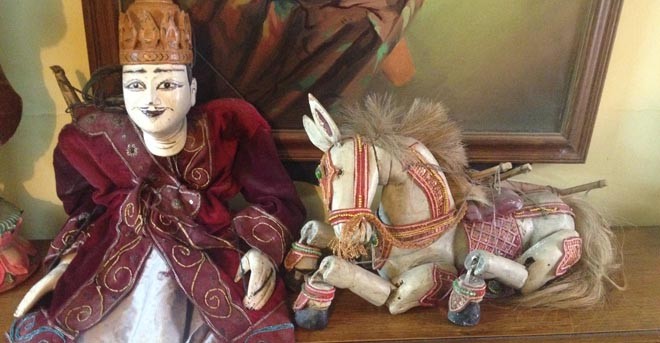

’m intrinsically footloose, restless, always eager to travel -- peripatetic.
I saw a foreign country for the first time when I was three. In the four decades hence I have travelled to nearly as many countries as the years in my life. I have souvenirs from two-thirds of them -- ever since I developed interests of my own that started reflecting themselves in steadily increasing acquisitions. Inevitably eclectically I collect, besides friends, globes, old maps, novels, bookmarks, writing instruments, masks, astronomy instruments, paintings, stamps (specially of countries that don’t exist anymore like Soviet Union and Yugoslavia), sail ships, music and films, and statues -- but especially puppets, from all over.
That’s probably the reason why people who visit our home call it a museum.
Perhaps what I really do is collect stories, interested in people and places as I’ve always been. Even though I ended up being a media person, I’ve always really wanted to be, variously, an astronaut, a deep sea diver, a teacher, an actor but maybe my most secret ardour has been to wish I could make puppets. Puppets fascinate me to no end seeming to be frozen stories.
That’s why when I travel I’m drawn to antique shops to seek out local puppets and marionettes, among other things. And so it was when I travelled to Yangon (Rangoon of yore) in the summer of 2011, I’d read up of ancient Burma’s rich royal heritage and hoped to seek out a couple of puppets. (I ended up buying eight and how I got them back home, including two massive pieces, on a limited baggage allowance is another story!)
Even though I’ve since returned to Yangon and it is changing so rapidly into the standard mall and mobile culture, it’s a land where history hangs heavy in the air with its magnificent pagodas, especially the famous 2,500-year old Schwedagon Temple housing as many Buddhas as its age. The Schwedagon complex has a massive souvenir market with a seemingly unending supply of characters and crafted motifs from the elaborate Buddhist pantheon (from where I chanced upon a 3.5 ft long wood carving of a reclining Buddha, which are rare and had to fight a bruising battle of wits to lay claim to it).
But the best bit of ancient Burma I managed to get was from what is known as the Bogyoke Aung San Market, formerly known as the Scott Market, named after Municipal Commissioner Christopher Scott but renamed to honour General Aung San, Suu Kyi’s father. (I also managed to visit her house but that again is another story). This is the most famous and popular local market in Yangon with over 1,600 shops, most selling art and craft.
One of antique shops there was run by an octogenarian who spoke immaculate English. I had a fascinating discussion with him. While sadly he didn’t have a puppet of Bahadur Shah Zafar, the last Mughal king who lies buried in the city, from him I purchased the best pair of puppets I ever bought -- of King Mindon (and his favourite horse Shas) of the Kongbaung lineage -- the last royal dynasty that ruled Burma from 1750s to 1880s.
Mindon created the second largest empire in the region’s history and came to lay the foundations of modern state of Burma through people-centered administrative reforms. Both puppets, while over 70 years old, are in fairly decent condition although my old African grey parrot managed to damage some of the fabric woven into its sides. Both Mindon and Shas have pride of place on the mantle of my Everett piano at home.